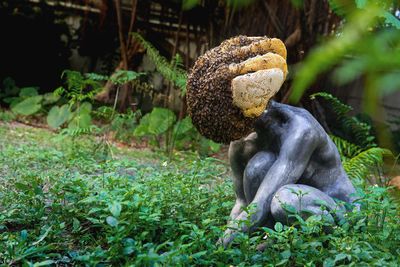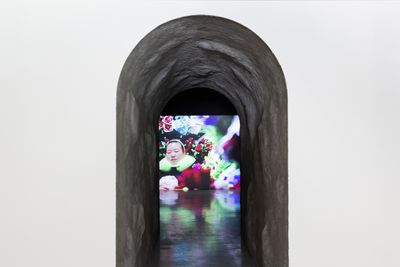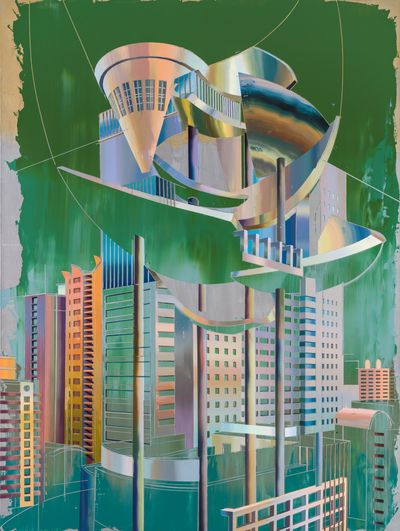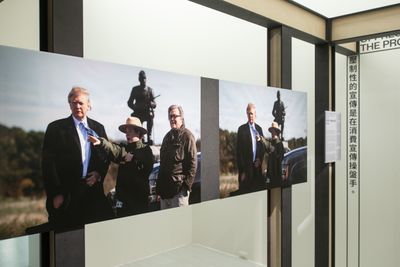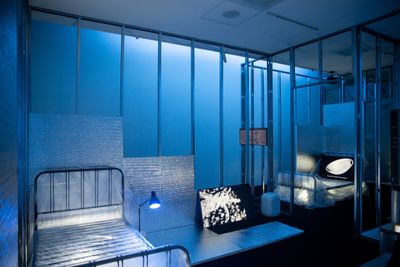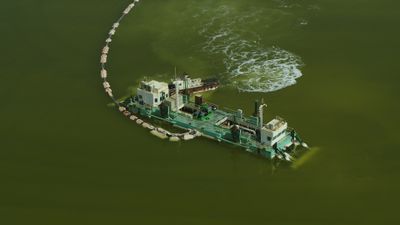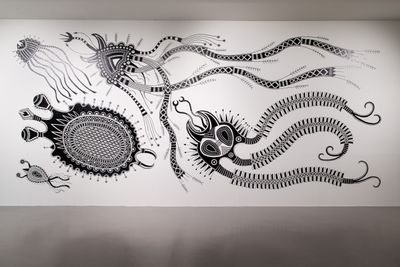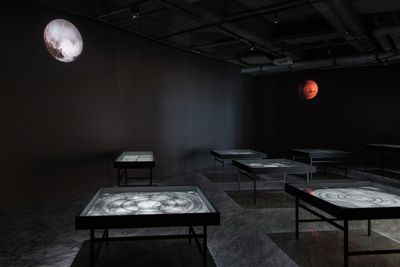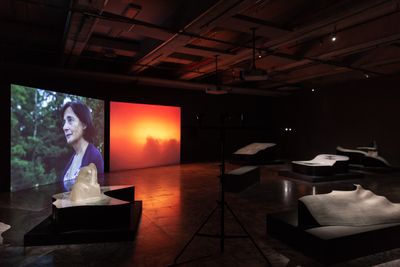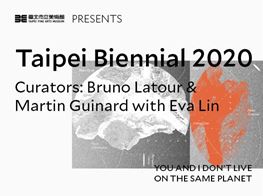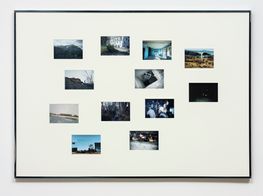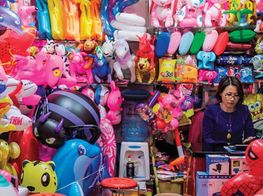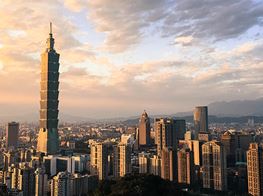12th Taipei Biennial Rethinks Globalisation
In Collaboration with Taipei Fine Arts Museum
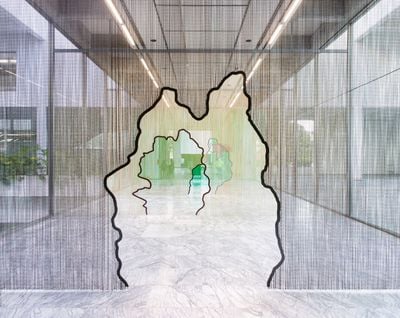
Daniel Steegmann Mangrané, ⧜ (2020). Kriska aluminium curtains and laser-cut, powder-coated steel frames. Dimensions variable. Exhibition view: 12th Taipei Biennial, You and I Don't Live on the Same Planet, Taipei Fine Arts Museum, Taipei (21 November 2020–14 March 2021). Courtesy the artist and Esther Schipper, Berlin, and Taipei Fine Arts Museum.
Curated by Bruno Latour, Martin Guinard, and Eva Lin, who is leading the exhibition's public programmes, the 12th Taipei Biennial, You and I Don't Live on the Same Planet (21 November 2020–14 March 2021), seems to refute the imagination of 'unity'. Rather, the curatorial considers difference as an entry point for understanding and rethinking processes of globalisation.
As the curators explained by email, this exhibition is 'not just thematic, but issue-based, with a philosophical question at its core: how to move towards an inhabitable world and how to deal with the lack of consensus to get there. This is something that artists, scientists, sociologists, philosophers, and activists all try to deal with from different vantage points, of course. The biennial serves as a good platform for people of different fields to meet and work together.'
Opening the show in the lobby of Taipei Fine Arts Museum (TFAM) is an installation of six kinetic sculptures resembling animals, made up of wooden structures and aluminium ladders by Mexican engineer and animist Fernando Palma Rodríguez, including Soldado (red) (2001) and Xi mo matlazacan ce cehce (2006).
According to the artist, in Nahua culture in Mexico, humans are not the only beings to have personas. Through their electrical charge, Palma posits these chimeras as alive, with electricity a 'persona' in its own right.
From here, the show expands into a galaxy of five sections defined as 'planets': Planet Globalization, Planet Security, Planet Escape, Planet Terrestrial, and Planet with Alternative Gravity. With 78 works by 57 artists and collectives from 27 countries and regions, the exhibition resembles a giant atlas, with chapters that are both independent and connected to each other.
Viewers are invited to begin the exhibition on the second floor, where a cave-like passage leads to Mika Rottenberg's film installation, Cosmic Generator (AP) (2017). The film spans different locations, including a Chinese restaurant in Mexicali, a city near the U.S. border in Mexico, and a market in Yiwu, China, selling goods such as fake flowers and plastic toys. These globally interconnected scenes set the tone for this exhibition chapter, Planet Globalization.
Here, the side effects of globalisation—namely inequality and climate change—are brought into view. Take Hicham Berrada's 180-degree panoramic video work, Présage (2020), which envelops the audience in the slow process of toxic chemicals solidifying in water, with the seductive colours of the metallic particles standing in for globalisation's deceptive sheen.
In muzungu (those who go round and round in circles) (2016), poet and artist Franck Leibovici and Julien Seroussi, a former analyst at the International Criminal Court, have assembled images, documents, and other evidence related to the Bogoro massacre in the Democratic Republic of Congo, spread across a wall. Audiences are invited to take evidence from the wall and compile it on magnetic boards in order to engage with the crime and its material.
Also on view in Planet Globalization are five paintings of modernist and postmodernist buildings by Cui Jie, including New Taipei City Hall, New Taipei City (2020). In a further reflection of Taipei's infrastructure, the mixed-media installation Making Friends/ Fire (2020) by Chin Cheng-Te, Lee Chia-Hung, Lin Chuan-Kai, and Chen Yi-Chun, placed nearby, is part of the following chapter, Planet Security, which considers protectionist responses to globalisation.
Making Friends/ Fire (2020) is composed of five television sets on short podiums, surrounding a column titled 'The Cold Plum Fort—a Cold War Monument', as well as documents and objects connected to the Kuomintang regime. The work responds to the site of TFAM, which is located near the Shilin and Beitou districts, where the Kuomintang government held power.
With 78 works by 57 artists and collectives from 27 countries and regions, the exhibition resembles a giant atlas, with chapters that are both independent and connected to each other.
Among the symbols of party power, some of which are still present on architectural infrastructure in Shilin and Beitou, is the plum blossom. The symbol was adopted during Cold War Taiwan—a period that is explored in the videos shown by the television sets, which offer civilian impressions of the regime as opposed to the state narrative that is explored throughout the installation.
Nearby, Jonas Staal's installation, Steve Bannon: A Propaganda Retrospective (2018–2019), is a deconstruction of the culture wars operated by the Trump administration. Staal has dissected ten movies produced by Bannon, including In the Face of Evil: Reagon's War in Word and Deed (2004) and Battle for America (2010), which are assembled into short videos that highlight the films' propaganda aesthetics.
What follows from the 'Bannon' booth, flush with propaganda and testosterone, is a room filled with extremely cold blue light. Corrupted Air – Act VI (2019) by Femke Herregraven is Planet Escape's only work: a refuge for the rich. The mixed-media installation resembles a bunker composed of plastic sheets and steel frames, evoking the aesthetic of a panic room.
On the first floor, Planet Terrestrial presents works by 22 artists and collectives that offer different lenses to perceive the world, in order to 'land on the earth for good and see where we might have to reside together.' The chapter is subdivided into two sections—Approaching the Terrestrial: Critical Zone and Approaching the Terrestrial: Gaia—that traverse topics including geology, cell biology, meteorology, and medicine.
In Approaching the Terrestrial: Critical Zone, Liu Chuang's commissioned three-channel video, Lithium Lake and the Lonely Island of Polyphony (2020), examines the lithium industry. Footage spanning lithium ore deposits in the Andes mountains to the Tibetan plateau is entwined with a study of polyphonic music, creating a textured exploration of the interconnections between music and technology.
A billboard-sized mural of viruses opens Approaching the Terrestrial: Gaia. Virus Series (2020), by Taiwanese Indigenous artist Cemelesai Takivalet, is a response to an incident that occurred in the artist's tribe, when a group of young people contracted a mysterious disease after conducting fieldwork. Reminded of the importance of keeping certain territories protected, as advised by the tribe's elders, the artist imagined a series of viruses unleashed from the wild as a result of human intervention.
Takivalet's mural reflects inventor James Lovelock and biologist Lynn Margulis' Gaia hypothesis that earth is a complex self-regulating system, with every element modified by life forms as small as bacteria—a signpost for Planet with Alternative Gravity in the basement.
Here, Chen Yin-Ju's Liquidation Maps (2014) references five historical events in Asia, including the Gwangju Uprising in 1980 in South Korea, and the Lieyu Massacre in 1987 in Taiwan. Composed of five large pencil sketches, the events are assembled to resemble astrological charts.
Located behind these drawings, June Balthazard and Pierre Pauze's Mass (2020) presents a conversation between 2019 Novel Prize winner, physician Michel Mayor and CERN Director of Research Chiara Mariotti, discussing scientific theories around the void. Their discussion is presented on two screens, surrounded by curved structures that resemble rock formations, lending to the 'metaphysical dimension' of the scientists' conversation, which attempts to make material the invisible notion of the void.
The dissertation-like Taipei Biennial comes to an end with a three-channel video of a lecture performance, Moving Earths (2019), by Frédérique Aït-Touati and Bruno Latour, that compares the work of 17th-century Italian astronomer and physicist Galileo Galilei, who attempted to prove that the earth moves, with contemporary perspectives of shifts on earth, commenting on the broader theme of the earth's 'mobility and changeability'.
Outside the museum, Pierre Huyghe's sculpture, Exomind (Deep Water) (2017), is composed of a woman's body with a beehive as a head. With its structure in endless transformation, the sculpture reflects the complex and interconnected systems that make up the planet, strengthening the core proposition of this dizzying Biennial. That humans are not the only creatures to hold power on earth.—[O]

